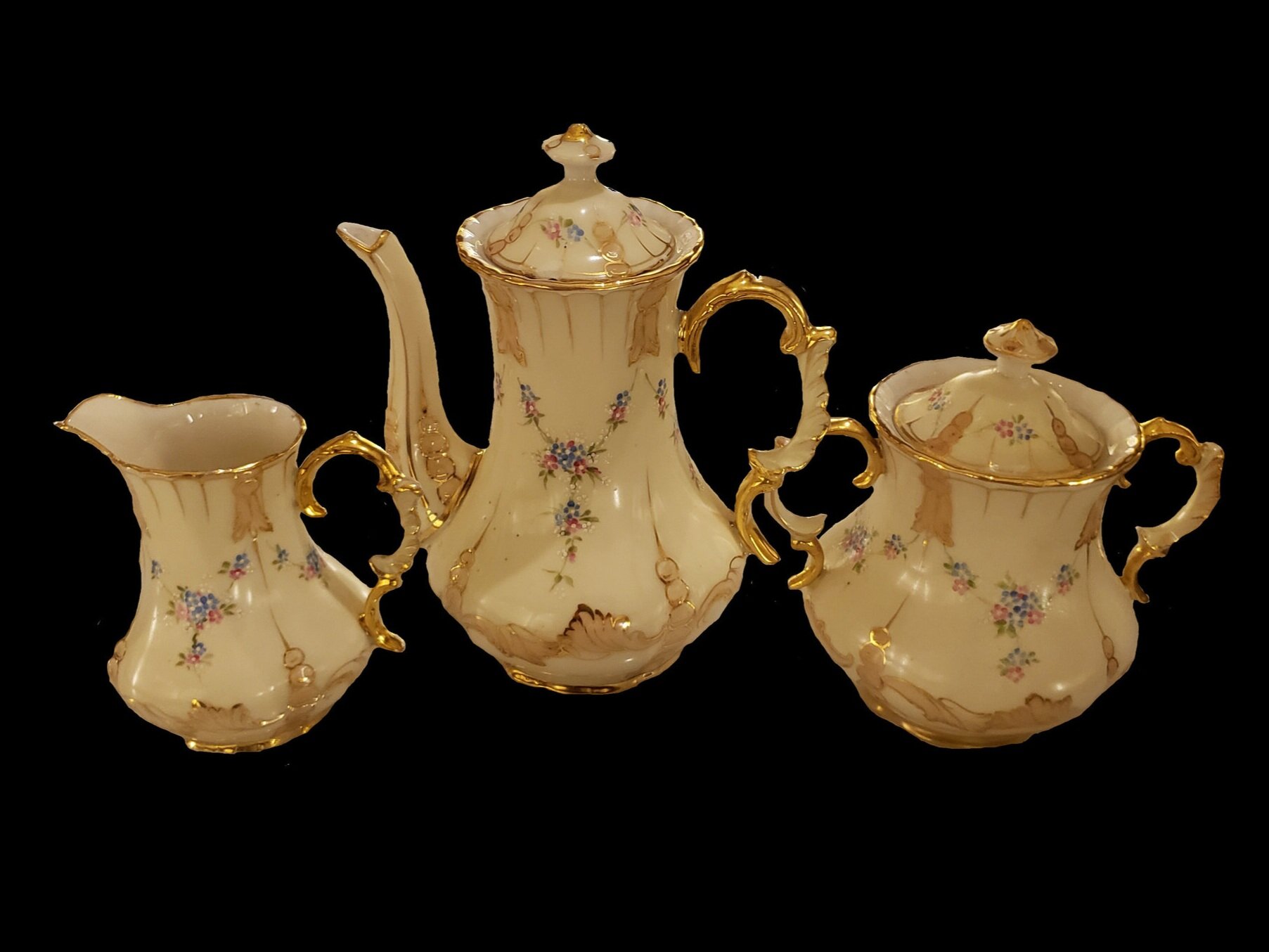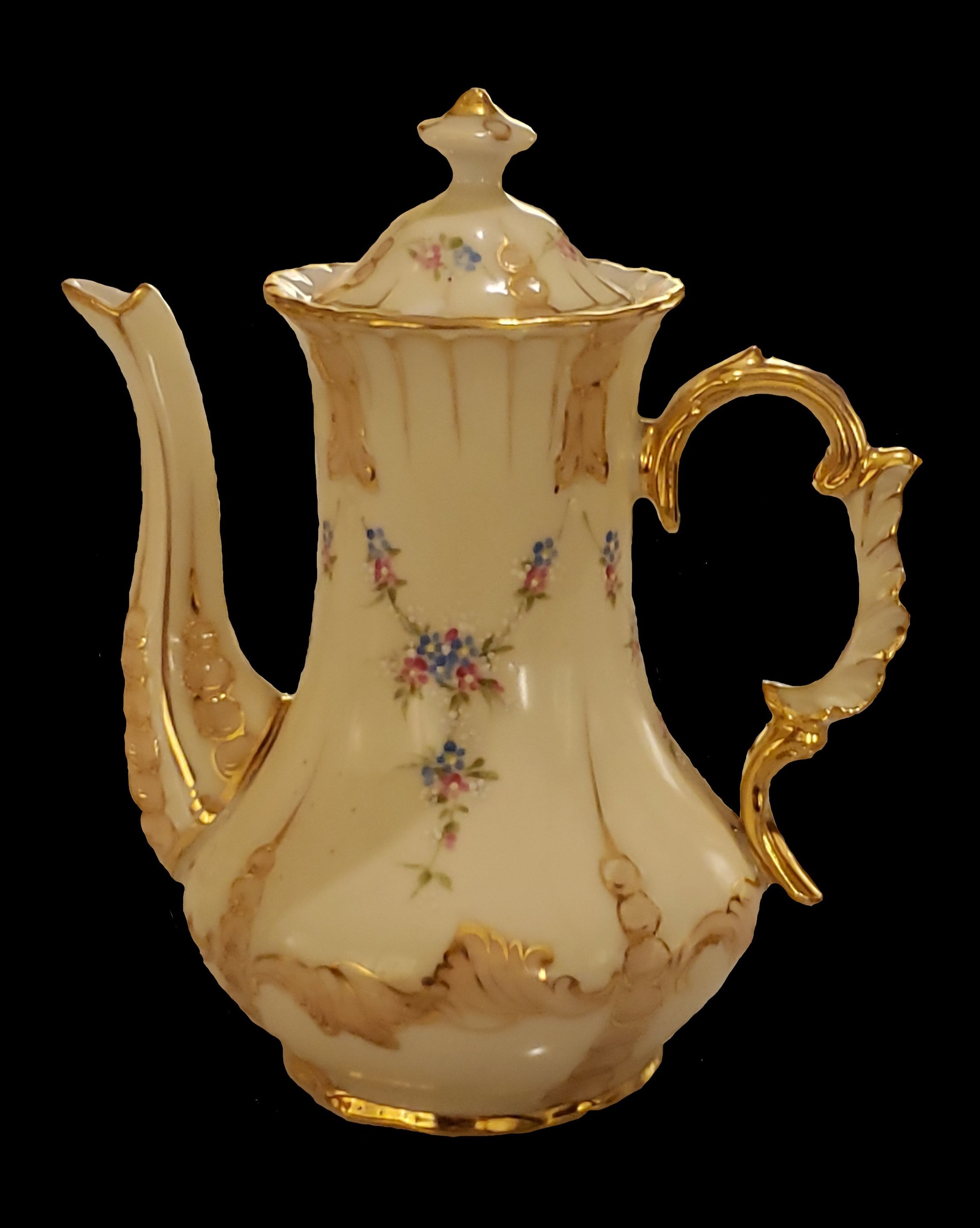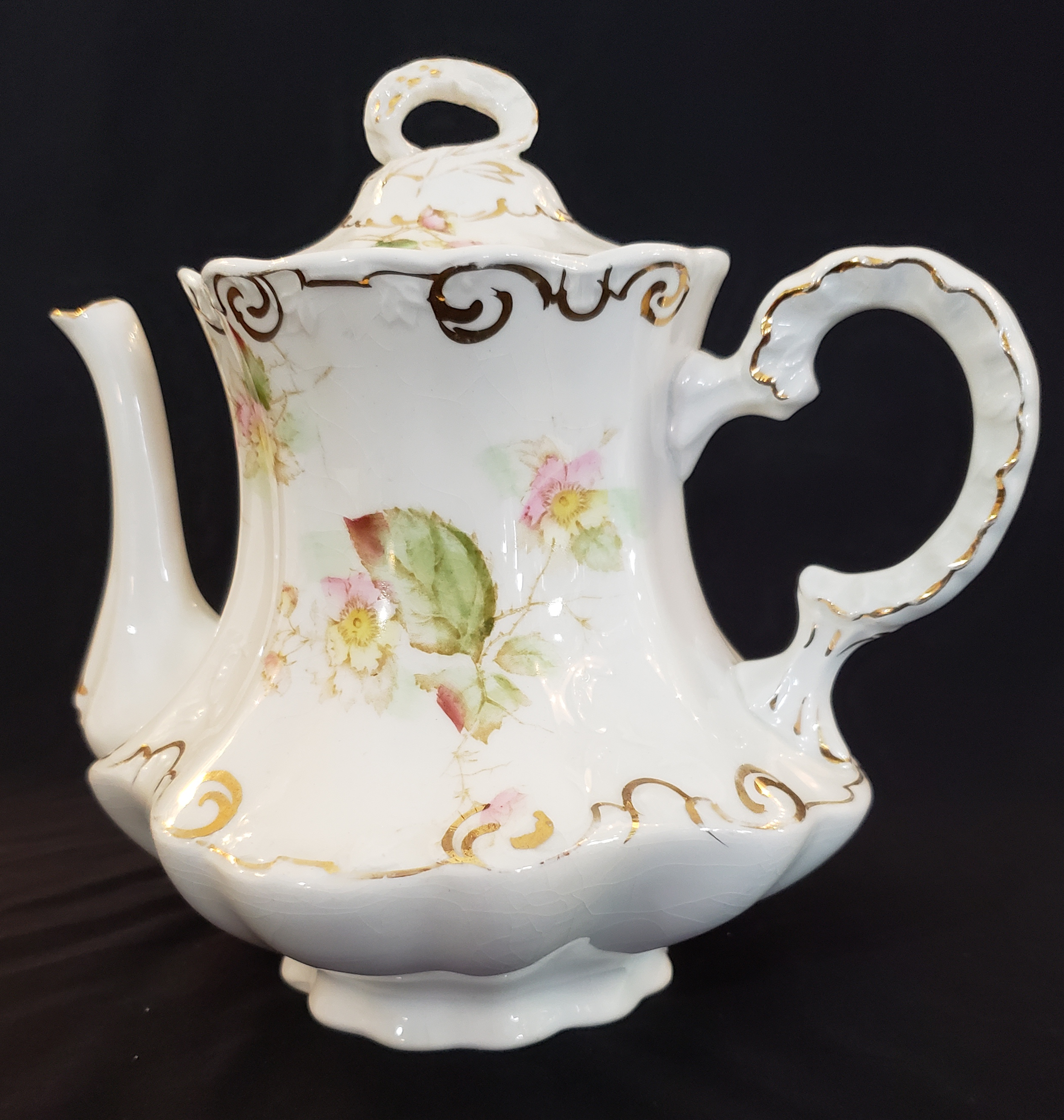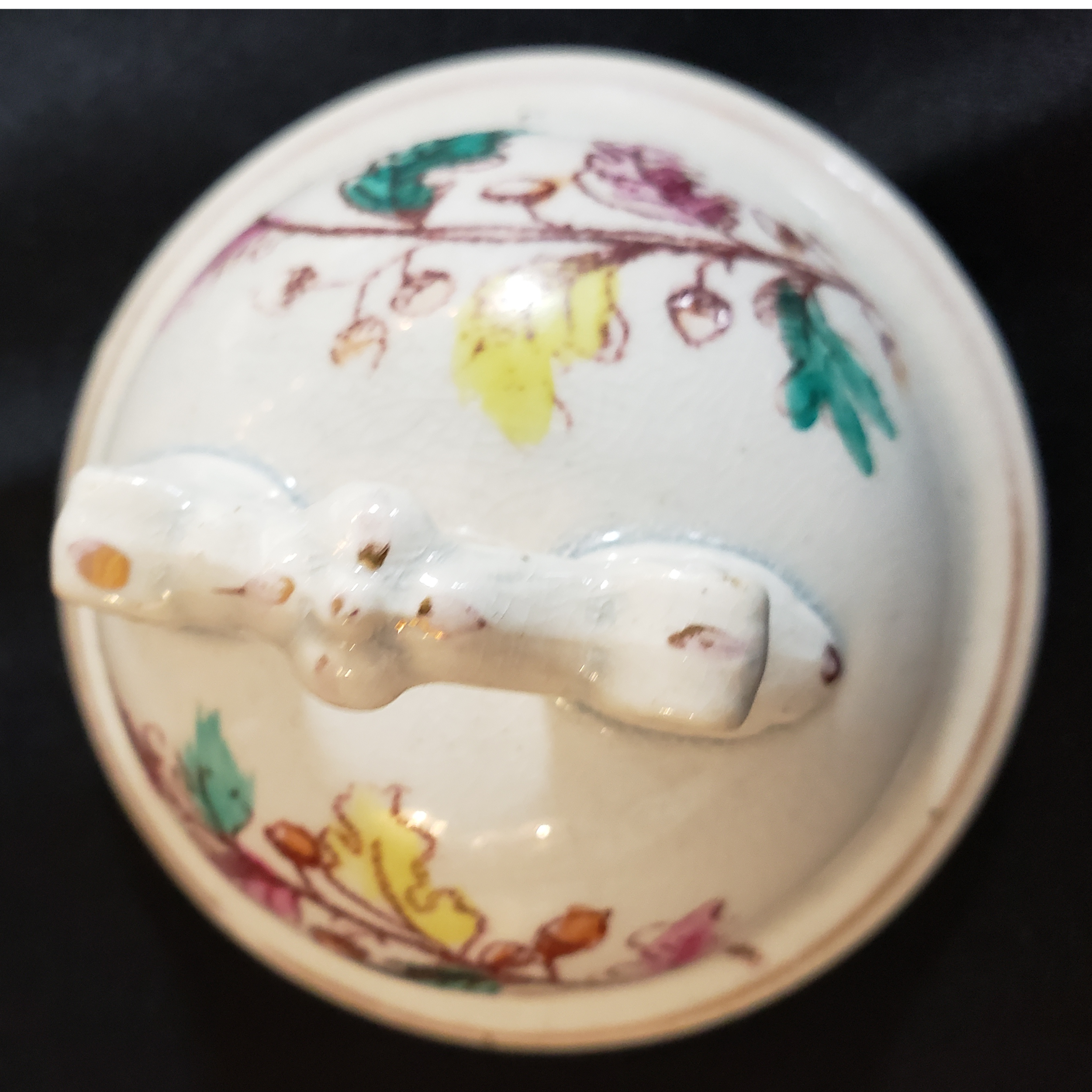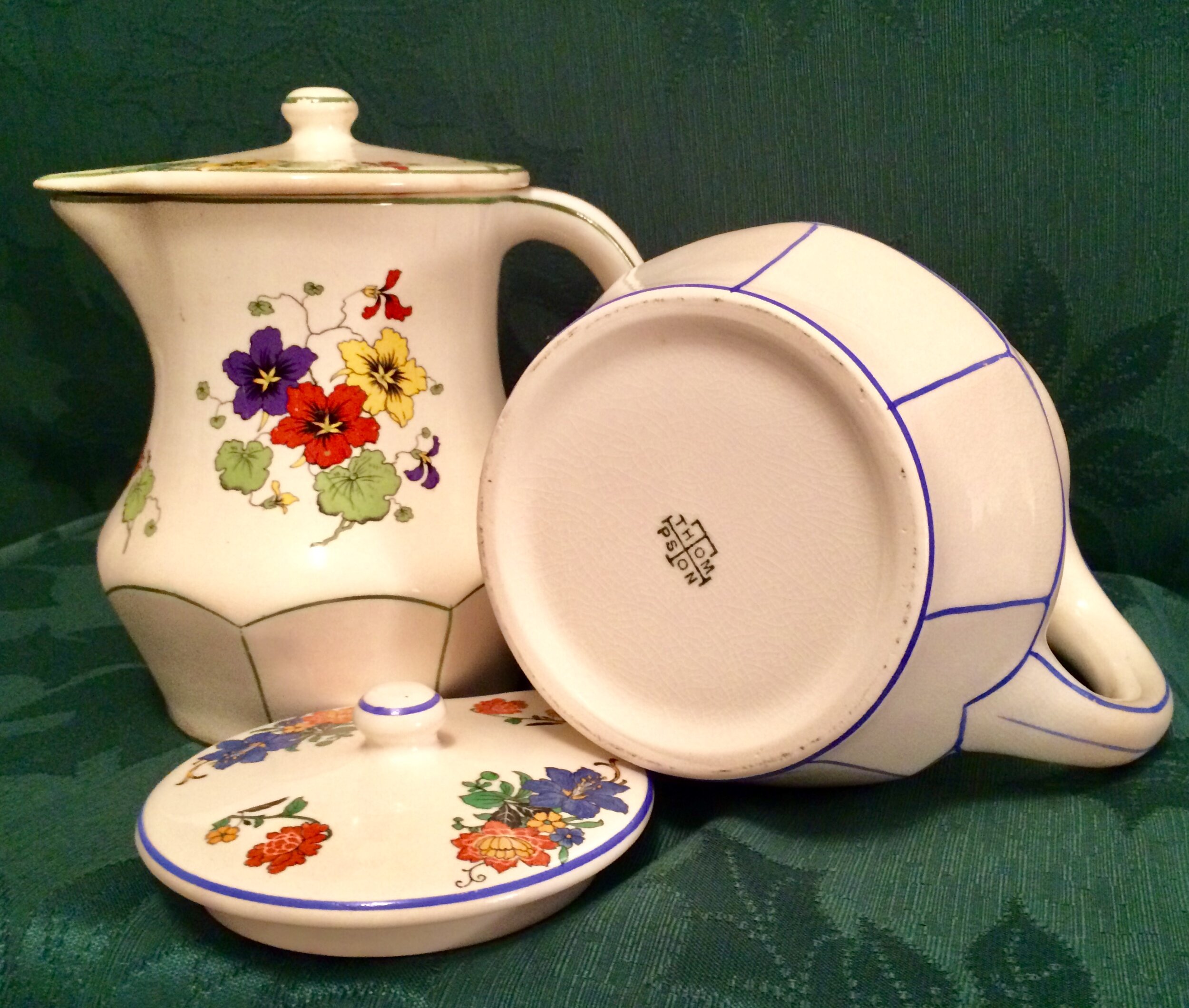Gallery ~ 1
Laughlin Brothers
TITLE: Porcelaine Granite Cable
MAKER: Laughlin Brothers Pottery Company
DATE: 1873-1877
COLLECTION: Museum of Ceramics/Ohio History Connection H1274_009
Homer and Shakespeare Laughlin, former residents of East Liverpool who had relocated to New York City, were enticed back to East Liverpool by an offered bonus of $5,000, and free land, to establish a new pottery. By September 1873, the money had been raised and the bonus accepted by the brothers. The two-kiln pottery was producing whiteware by October 1874. (Gates, 1984).
Homer Laughlin China Company
TITLE: World’s Fair 1893
MAKER: Homer Laughlin China Company
DATE: 1892
COLLECTION: Museum of Ceramics/Ohio History Connection H1281_001
This Danube shape set won a prestigious award for pottery at the 1893 Chicago World’s Fair. The set is very small, perhaps made more for beauty than function.
Several East Liverpool potteries won high awards at the 1893 World’s Fair and other national exhibitions.
TITLE: Harlequin
MAKER: Homer Laughlin China Company
DATE: 1936 - 1964
COLLECTION: Museum of Ceramics/Ohio History Connection
Sold exclusively through the F. W. Woolworth stores, Harlequin was designed by Fredrick Rhead, the designer of Fiesta Ware. Originally produced in four colors, yellow, green, blue, and a red (described as maroon), Harlequin was eventually produced in all Fiesta colors except ivory and deep cobalt blue. (Kellner, 2018, Nossaman, 2002).
Frederick Rhead, was a Staffordshire potter who came to East Liverpool toward the end of his career. He emigrated in 1902 and would take the position as art director at Homer Laughlin in 1927. He had a varied career including running his own potteries: the Rhead pottery in California and the Roseville and Weller potteries in Ohio. Rhead, introduced Fiesta Ware in 1936 and would also design the Virginia Rose and Harlequin lines. Rhead died from cancer in 1942.
TITLE: Priscilla
MAKER: Homer Laughlin China Company/Household Institute
DATE: 1941
COLLECTION: Phyllis Conley
Produced through an agreement with the Club Aluminum Society this Republic shape teapot with the Priscilla pattern was produced with the Household Institute stamp.
TITLE: Shakespeare
MAKER: Homer Laughlin China Company
DATE: 1886-1900
COLLECTION: Museum of Ceramics/Ohio History Connection H1310_001
The Shakespeare shape was introduced in 1886 and named in honor of Shakespeare Laughlin, an original owner in Laughlin Brothers. who had died in 1881. The shape was discontinued before 1900 when the Homer Laughlin China Company moved to Newell, WV. (Gonzalez, 2018).
TITLE:
MAKER: Homer Laughlin China Company
DATE: 1896
COLLECTION: William and Donna Gray
This teapot was made in Ohio at the Homer Laughlin River Road plant. In 1905 Homer Laughlin opened its plant in Newell, West Virginia. Several local potteries moved across the Ohio River at the beginning of the 20th century.
TITLE: Victor
MAKER: Homer Laughlin China Company
DATE: 1877-1900
COLLECTION: William and Donna Gray
The Victor shape from Homer Laughlin came with “two types of finials; the open, fluted style (which matches the handles) and the closed, ornate version.” (Gonzalez, 2016). Both examples are included here.
Tea Trivia:
Herbal teas are not actually teas. They do not contain leaves from the plant, Camellia sinensis. They are actually blends made from the roots, leaves, flowers, seeds, and/or fruits of various plants. (Kenna, 2021).
TITLE: Eggshell Nautilus
MAKER: Homer Laughlin China Company/Geo. H Bowman
DATE: 1920s
COLLECTION: Phyllis Conley
Gold and Iridescent glaze make this teapot shimmer in a variety of colors.
In 1916, George H. Bowman, the largest wholesale and retail dealer in cut glass and decorated china in the Unites States, purchased the old American Chicle Co (chewing gum) buildings in Salem, Ohio. Bowman was based in Cleveland where he had a successful store on Euclid Ave. Bowman’s wife, Mary, was originally from Salem. Bowman accepted an offer from Salem City officials to expand his operations to Salem. Production in this decorating shop began at the renovated plant in October 1916.
Bowman and his family remained in Cleveland until the Depression forced him to close his Cleveland store. He relocated to Salem. Bowman was the factory representative for the Homer Laughlin China Company, Taylor, Smith & Taylor, Universal Potteries and the Harker Pottery. Bowman would purchase undecorated ware, add decoration, then place his stamp over the original manufactures mark when the product was complete.
Bowman was dedicated to his work and spent hours at the plant managing and working alongside his employees. George H Bowman retired in 1955 at the age of 88. (Firestone, 1992).
Tea Trivia:
People in the United States love their tea sweet. It is estimated that about 85 percent of tea sales are for iced tea with sugar added. (Chamberlain, 2019).
TITLE: American Beauty
MAKER: Homer Laughlin China Company
DATE: 1898-1910
COLLECTION: William and Donna Gray
Introduced in 1898, American Beauty was one of Homer Laughlin China Company’s most successful styles. By 1903, there were 230 different treatments available on the American Beauty shape. However, by 1905, after the introduction of the Angelus shape, the style began to decline. It was discontinued by 1910. (Gonzalez, 2018). The pattern shown here is Oak Leaves, style 331.
TITLE: Rococo
MAKER: Homer Laughlin China Company
DATE: 1891-1900
COLLECTION: William and Donna Gray
The Homer Laughlin Rococo shape is found in plain or with simple decorations such as the pictured teapot in gold. An advertisement in Pottery and Glassware Reporter (1893) the Rococo is highlighted as an award winning line of Homer Laughlin dinnerware. (Cunningham, 1998).
Tea Trivia:
Accidents sometimes do have wonderful results. In 1908, Thomas, a New York coffee and tea shop merchant, began shipping product samples in small silk bags. His intent was for patrons to simply empty the tea or coffee and brew the product. However, many put the bags directly into the pot like they would have with a diffuser. It is also possible the tea bag was invented by two women - Roberta Lawson and Mary McLaren - who, in 1901, submitted a patent for an invention which closely resembled the modern tea bag. (Kenna, 2021).
C.C. Thompson Company
TITLE: Chatham
MAKER: C.C. Thompson Pottery Company
DATE: 1916-1938
COLLECTION: Mary Martha Koos
Cassius C. Thompson and J. T. Herbert started the Thompson and Herbert pottery in 1868, producing Rockingham and yellowware. In 1880, Josiah Thompson, Cassius’ father, bought out Herbert and the company operated as Thompson and Company until 1889 when Josiah passed away and the company incorporated as C. C. Thompson Pottery Company and added white ironstone ware to the production line. (Gates, 2009).
TITLE: Wentworth
MAKER: C.C. Thompson Pottery Company
DATE: 1927-1938
COLLECTION: William and Donna Gray
The C.C. Thompson Company closed in 1938 after 70 years of continuous service in East Liverpool. Citing lack of demand for the ware and poor prices as a factor in the closing, George C. Thompson, company president at the time, reluctantly closed the pottery, furloughing about 300 employees. The Wentworth shape seen here would have been one of the last styles of teapot to come off what was considered a modern line. (C.C. Thompson, 1938).
TITLE:
MAKER: C.C. Thompson and Company
DATE: 1883-1890
COLLECTION: Mary Martha Koos
The shape, pictured here and seen throughout the exhibit, was popular for potteries as manufacturers transitioned from the Rockingham and yellowwares of the mid to late 19th century to the whitewares of the early to mid-20th century. The shape, both functional and decorative, shows the transitions from heavy utilitarian ware to the more delicate, detailed whitewares of the mid to late 20th century.
TITLE: Cottage
MAKER: C. C. Thompson and Company
DATE: 1883-1890
COLLECTION: William and Donna Gray
The Museum of Ceramics owns a similar shape in Rockingham glaze. Molds were reused as the potteries transitioned to whiteware and cream glazes.
This common Thompson trademark, with a hint of English style, is interesting for its clarity and design.
TITLE:
MAKER: C.C. Thompson and Company
DATE: 1883-1890
COLLECTION: William and Donna Gray
In the January 1898 edition of Illustrated Glass and Pottery World, the C. C. Thompson Company was touted as the largest manufacturer of Cream Color (C.C.) ware, semi-granite, Rockingham and yellowware in the world. (Illustrated, 1898)
TITLE:
MAKER: C.C. Thompson Pottery Company
DATE: 1916-1938
COLLECTION: Mary Martha Koos
In 1931 the C. C. Thompson Pottery company spent $100,000 (equal to $1.7m in today’s money) to dramatically upgrade their plant. The company installed two continuous kilns while also retaining six of the existing upright (bottle) kilns. The construction increased the capacity of the company by 20%. Sadly, eight years later the pottery would close. (Gonzales, 2017).
The McDevitt Companies
TITLE: Redware
MAKER: McDevitt, Keffer and Co, McDevitt, Cochran and Company, McDevitt, Moore and Curby, McDevitt and Moore.
DATE: 1868-1870, 1872-1874, 1874-c.1900
COLLECTION: Museum of Ceramics/Ohio History Connection H198
Located in what became known as the California Hollow area of East Liverpool, through which State Route 11 and Dresden Ave now run, and called in advertising and by locals, the California Potteries, the McDevitt potteries were a small enterprise. At one time, they employed only six workers. According to W. A Calhoun, the potteries were named “California” not from the original location name but by locals because they were located at a distance from the main business and pottery area of East Liverpool. Thus, the Carpenter Hollow became California Hollow and the McDevitt and Moore pottery the “California Pottery.” An area of the East End of the city became known as Klondike (after the gold rush area of Alaska) to signify distance from the center.
Primarily producing Rockingham and yellowware the company stabilized in 1874 when Edward McDevitt, an Irishman who had apprenticed in potteries in Glasgow, Scotland, and Steven Moore, a potter from Staffordshire, England, became the sole proprietors. As McDevitt and Moore, the company prospered for over 20 years, finally meeting its demise due to its location. Although the raw products of clay, coal and water were plentiful in the hollow the pottery was over a mile from the Ohio River and the railroad, which ran along Second Street in East Liverpool. A proposed, and hoped for, line from the river to Lake Erie through the hollow was never built. (Brookes, 2019, Calhoun, 2020).
TITLE: Redware
MAKER: McDevitt and Moore
DATE: 1868-1900
COLLECTION: Museum of Ceramics/Ohio History Connection H220
A note on the bottom reads: “Mrs. N J Pittinger from Moore and McDevitt.” Redware is a pottery base high in iron. It produces a red color when fired. Redware is porous and must be waterproofed for use. The iron in the clay and lead in the glazes were toxic to both users and producers. Redware often featured complicated surface decoration. Although a few areas continued to produce redware, its wide spread production ceased during the mid to late 19th century when stoneware and whiteware, which were much stronger, became the accepted base for wares. (Redware, 2021).
Globe Pottery
TITLE:
MAKER: Globe Pottery Company
DATE: 1888-1901, 1907-1912
COLLECTION: Museum of Ceramics/Ohio History Connection
This example, attributed to the Globe Pottery Company, is whiteware with a black glaze and hand painted floral design.
The Globe Pottery Company began as Frederick, Shenkle, Allen and Company in 1881. In 1888, the pottery reorganized as the Globe Pottery Company. Globe joined the short-lived East Liverpool Potteries Company in 1901 but resumed production under its original name in 1907 when the cooperative failed.. The Globe pottery produced Rockingham and yellowwares, semi-porcelain dinner and toilet wares. The pottery ceased operations in 1912.” (.Globe, 2020).


